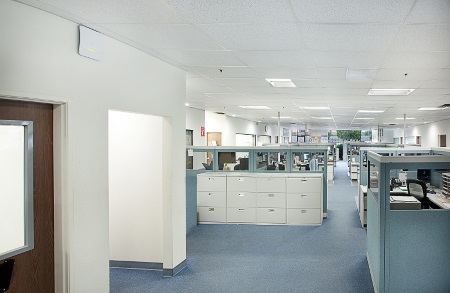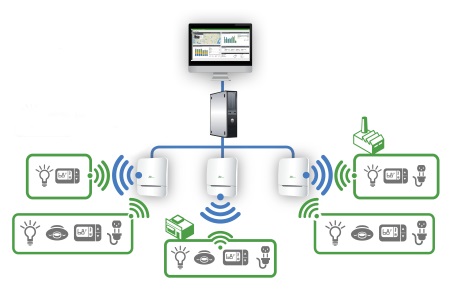BY MANDEEP KHERA
Vice President, Marketing & Channels
Daintree Networks
www.Daintree.net

Fig. 1: Example of wireless networked office (Courtesy UnitedStationers, Sacramento, CA)
Responsible for more than 40% of the world’s energy consumption, inefficient buildings are becoming the target of stringent government regulations, utility incentive programs, and green building certifications. As a result, they’re creating an opportunity for real change in building energy usage. High-quality solid-state lighting (SSL) luminaires are being developed for the commercial environment, and there is a growing awareness of the various benefits associated with implementing wireless controls for lighting, HVAC (thermostat), and other building controls in one integrated solution.
Wireless controls’ growing “rock star” status is due both to the significant cost savings realized from the reduction in labor required for installation and the energy savings that smart energy management enables. The cost of wiring alone is incentive for many building owners to make the move to wireless systems. Because they are wireless, these control devices are particularly well suited for existing buildings and retrofit projects where running additional wiring is not feasible. Today, architects, building planners, and facilities managers must make energy management a key component of new and retrofit installations. To help keep costs low and to further the adoption of control technology, an open-standards-driven approach to wireless controls and building energy management in general is the most effective.
A different drummer
New approaches are being developed to reach commercial energy-conservation goals. Open-standards-driven solutions provide interoperability between the different devices and give customers a choice of devices, which drives competition between manufacturers to keep costs down and provides the ability to manage lights, sensors, thermostats, and plug loads made by from different vendors.
Many of today’s energy control systems fall into the proprietary category. Proprietary systems for managing and monitoring lighting, thermostats, plug loads and other energy-related functions in buildings are technologically isolated from each other, using separate, non-interoperable networks and user interfaces. This process is not only costly and complex, but sometimes difficult to accomplish at all. Moreover, customers using a single-source supplier cannot easily incorporate software technology and devices from other companies, and find themselves locked in to a single company’s system – one that can be very difficult to install, commission, and maintain over time.
Open standards have greatly facilitated integrating devices from different vendors into a building’s overall energy scheme. Eliminating wiring and using open standards such as ZigBee allows broader and more granular control, provides a wide choice of lower-cost products and capabilities, simplifies commissioning, and extends the benefits of control to retrofits and other new markets.
Using wireless technology to manage energy in buildings can also provide operational efficiencies that help reduce business risk through fault detection and proactive maintenance. Further benefits include occupant comfort and productivity—good lighting can increase productivity by nearly 10%, while employees make 44% more mistakes in too-cold office environments. Retail and food service chains depend on outdoor signage and lighting to denote when stores are open or closed. When signs and lights unexpectedly go out, an otherwise open restaurant may look closed to potential customers, leading to loss of revenue.
Command performance
“Demand response” is becoming an important component for facility managers, as it allows them to reduce or shift their power use during peak demand periods. By implementing wireless control technology that allows utilities to talk to devices inside the premises, facility managers can address several areas: pricing, emergency response, grid reliability, infrastructure planning and design, operations, and deferral. Wireless controls that can integrate with the OpenADR (Automated Demand Response) Communications standard enable utilities to manage supply during peak times.

Fig. 2: Implementing a platform built around an easily monitored network lets users make actionable decisions based on the information being transmitted and collected.
Companies also benefit from significant utility rebates. In the process, less energy is wasted and less new energy production is required. Wireless OpenADR certified solutions allow lighting, HVAC, and plug-load control strategies to be created for automated response to an OpenADR event, facilitating California’s Title 24 compliance as well as other government regulations. Smart building energy management is also the most critical piece of the Enterprise Internet of Things (E-IoT), where the building is the core of the enterprise with people and machines working together inside the building.
Here to stay
Wireless controls really play to their “rock star” potential as part of the roadmap for smart buildings and foundation for the E-IoT. The E-IoT is the next frontier for wireless networked building controls. The wireless capability helps organizations drive their E-IoT initiatives, enabling them to manage all machine-to-machine (M2M) communications throughout their networked enterprise.
By implementing a platform built around an easily monitored network, users can make actionable decisions based on the information being transmitted and collected. This is vital to ensuring the value of our growing connectedness, as well as protecting the integrity of the massive amount of data being passed across the building enterprise. The right open standards-driven wireless technology can help organizations implement their E-IoT initiatives, enabling them to manage all M2M communications throughout their networked enterprise.
Standing ovation
Networked wireless control technology- based on open standards- is the ‘rock star’ of the E-IoT because it delivers:
• * Simplicity, bringing an end to the typical building control cycle of highly complex wiring
• * Choice of open-standards-driven, interoperable building products from trusted suppliers
• * Flexibility, enabling building managers to redesign their spaces to address today’s dynamic work environments without the limits to hard wire a device
• * Higher return on investment and faster payback by removing the wires from building control devices, and adding continuous and on-demand energy load reduction while complying with building regulations
• * Scalability, facilities team can remotely manage wireless systems that scale from a single room, entire floor or building, up to a complete portfolio of buildings
• * A foundation for the E-IoT, the next frontier in wireless building energy management and M2M communications
Advertisement
Learn more about Daintree Networks, Inc.





